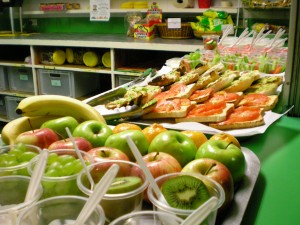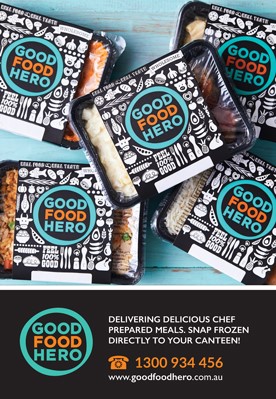Menu essentials
 Carefully planning your menu is important. It should offer your customers some core items that seldom change, with variety provided by daily specials or on particular days of the week. These can be either recess or lunch specials. Seasonal fruit should be available year-round and presented in an attractive and appropriate way (e.g. cut or whole). Here are some things to think about when planning your menu:
Carefully planning your menu is important. It should offer your customers some core items that seldom change, with variety provided by daily specials or on particular days of the week. These can be either recess or lunch specials. Seasonal fruit should be available year-round and presented in an attractive and appropriate way (e.g. cut or whole). Here are some things to think about when planning your menu:
1. Find out what your customers want
In a primary school decisions are made mostly by the parents, but by high schools, the food choices are completely up to the students. Plus, you have teachers and administration staff who may use the canteen. Once a year create a simple, tick-box survey as a way to gain feedback from your customers. Provide a range of new options that you are willing to provide and ask for them to be ranked or ticked. This will give you some control as to what you offer and help limit unrealistic and unhealthy requests.
2. Create a menu that is both appealing but manageable
A good compromise between offering sufficient choice for customers, while keeping the overheads (storage requirements and preparation time) down, is to limit the menu. Here are some suggestions:
- Offer up to 10 sandwich/wrap fillings, no more.
- Only provide 8 snack foods available at recess and lunch.
- Offer only 8 hot food varieties throughout the week – with only 2 to 3 available each day.
- Keep up to 6 frozen items stocked, no more.
- Water and only 3 milk and juice flavours each.
Having too many items on the menu can cause issues for storage and profitability. Understand your best sellers and remove slow-selling items. However, be careful not to remove slow moving products that are stocked to cater for specific medical or cultural needs of students (such as soy drinks or non-yeast and gluten-free bread products).
3. Balancing your menu
Too often canteens offer a whole host of Occasional packaged hot foods and snacks for ease of operation, but these items should only be eaten sometimes and in small amounts.
Limit the number of OCCASIONAL options on your menu and make sure only the healthiest versions of these foods (Health Star Rating of 3.5 stars and above) are sold in your school canteen. Maximum portion size limits for all OCCASIONAL items also need to be met.
Our tops tips:
- Fill your menu with at least ¾ EVERYDAY and no more than ¼ OCCASIONAL food or drink in each section of your menu.
- Check portion sizes and that all OCCASIONAL foods have a Health Star Rating of 3.5 stars and above.
ACT and SA school canteens: limit AMBER options
A menu that meets the SA Right Bite strategy and ACT National Healthy School Canteen guidelines has:
- No RED items, including no banned RED drinks.
- More than 50% of GREEN items.
- Less than 50% of AMBER items.
We recommend reducing the number of AMBER options in each section of your menu available by not serving all of the AMBER options everyday. Try removing the lower selling AMBER foods from the menu and limit them to two per section per day. For instance, instead of offering sausage rolls, chicken nuggets, pies, commercial pizza and instant noodles each day, split them up so they’re only offered on certain days of the week.
prepackaged hot foods for ease of operation, but these items should not be offered every single day. For instance, instead of offering sausage rolls, pies, chicken nuggets, lasagne, fried rice, beef and chicken burgers each day, split them up so they’re only offered on certain days of the week. Spreading the AMBER hot items across the week limits the availability of unhealthier foods, but also makes preparing the meals much easier and streamlined for canteen staff.
5. Use your state/territory association to help plan your menu
Each state or territory generally has a body that supports and advises school canteens – In NSW, SA and ACT, it’s us. In most instances, there is a policy/strategy/guideline that determines what food and drink can and cannot be sold in schools. Find out which organisation advises your state on our government policy page.
Don’t forget to look at the healthy canteen guidelines for your state to ensure you’re meeting the policies. And like our Facebook page to keep up with what’s going on in the world of kids nutrition, school canteens and healthy eating
Sample canteen menus
For ACT and SA schools, if you’d like to see a ‘before and after’ menu, one that has gone from RED and AMBER to GREEN, there is a working example here.
6. Get Savvy with pricing
Don’t forget, to run a successful canteen you need to be savvy at pricing. Make sure you charge enough for the items on your menu. Mark up will vary according to your canteens’ situation. Mark-ups cover all expenses such as electricity and gas, wages and employment costs (if there are any), lease fee (if there is one), maintenance costs and profit, as well as the cost of the goods (goods and packaging).
The mark up you use is influenced by numerous factors, including canteen running costs and operating model, desired profit and any policy that may encourage the sale of healthier items. See the finance page for more information on menu pricing.






